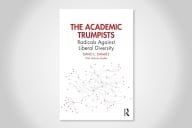You have /5 articles left.
Sign up for a free account or log in.
By last September, the economy had taken a dive, leaving many Americans in significantly worse financial circumstances than they had been in just a few months before. So it was little surprise that when the federal government presented its latest data on student loan defaults -- which focused on a period ending in September 2008 -- the numbers showed a sharp upturn reflecting borrowers' increased economic distress, rising to their highest level in a decade.
The U.S. Education Department reported Monday that the 2007 "cohort default rate" -- the proportion of federal loan borrowers who began loan repayments between October 2006 and September 2007, and who defaulted on their loans by the end of September 2008 -- had risen to 6.7 percent, from 5.2 percent the year before.
For-profit colleges and universities had by far the highest default rates, but rates rose by roughly the same amounts across sectors, suggesting that the economy affected borrowers similarly at different types of institutions.
“The economic downturn likely had a significant impact on the borrowers captured in these rates,” Education Secretary Arne Duncan said in a news release about the rates. “The department is reaching out to make sure current and prospective student borrowers are aware of the many flexible repayment options designed to assist them with their financial obligations," including the income-based repayment plan created as part of last year's Higher Education Opportunity Act.
(That law also made changes that will almost certainly cause institutions' default rates to rise beginning in 2012, when the government starts calculating the rates over a three-year rather than two-year window; the change was made because of the perception that the short window of time failed to capture the true rate at which borrowers are struggling to repay their college debt.)
As has historically been true, students at for-profit colleges defaulted at the highest rate -- 11 percent. Two-year public college students followed at 9.9 percent.
Cohort Default Rates from 2005 to 2007, by Type of Institution
| 2005 | 2006 | 2007 | ||||
| Institution Type | Default Rate | No. of Borrowers Entering Repayment | Default Rate | No. of Borrowers Entering Repayment | Default Rate | No. of Borrowers Entering Repayment |
| Public | 4.3% | 1,803,195 | 4.7% | 1,988,185 | 6.0% | 1,721,629 |
| 2-3-year | 7.9% | 463,007 | 8.4% | 523,749 | 9.9% | 483,721 |
| 4-year | 3.0% | 1,332,621 | 3.4% | 1,456,258 | 4.3% | 1,230,076 |
| Private | 2.4% | 950,819 | 2.5% | 1,055,567 | 3.8% | 778,296 |
| 2-3-year | 6.7% | 21,819 | 6.1% | 18,278 | 8.1% | 14,798 |
| 4-year | 2.3% | 924,566 | 2.4% | 1,033,700 | 3.6% | 759,960 |
| Proprietary | 8.2% | 730,385 | 9.7% | 855,523 | 11.1% | 838,328 |
| Less than 2-year | 8.9% | 141,953 | 10.9% | 140,302 | 12.0% | 129,627 |
| 2-3 year | 9.3% | 240,545 | 11.1% | 267,869 | 12.5% | 262,640 |
| 4-year | 7.2% | 347,887 | 8.4% | 447,352 | 9.8% | 446,061 |
| Total | 4.6% | 3,495,584 | 5.2% | 3,911,640 | 6.7% | 3,345,534 |
Two vocational institutions -- Healthy Hair Academy, of Dallas and Jay’s Technical Institute, of Houston -- face penalties from the government because their cohort default rates exceed 40 percent.
Defaults have fallen significantly since they peaked in 1990, before regulatory and other changes made by the government, lenders and colleges brought them down, as seen in the chart below. But until this year, they had not climbed above 6.0 percent of all borrowers since 1998, when they were 6.9 percent.
The rate was higher among borrowers at colleges in the Federal Family Education Loan Program (7.2 percent), compared to 4.8 percent for those in the competing direct loan program. The department explained that that was at least in part because the guaranteed loan program "has a larger percentage of proprietary schools, which have higher default rates, and a lower percentage of public and private 4-year schools, which have lower default rates."










